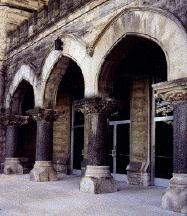Gregory Galperin will give the Friday afternoon colloquium this week.
He will discuss the dissection of polgons. In particular, if you dissect a polgon using the diagonals and the triangular pieces have rational area, what can be said of the inner piece?
Friday, October 30, 2009
Monday, October 26, 2009
Darin Johnson Gives Lecture on Rook Polynomials
The rook problem is related to the number of nonattacking rooks that can be placed on a Ferrers Board. A Ferrers board is a board in which the number of cells in a column is always nondecreasing from left to right until it terminates. A rectangular board is a simple example of a Ferrers board.
Dr. Johnson showed how the Rook problem on the Ferrers board generates various polynomial coefficients which are in turn related to several examples of well known number sequences in mathematics and combinatorial number theory.
Dr. Johnson showed how the Rook problem on the Ferrers board generates various polynomial coefficients which are in turn related to several examples of well known number sequences in mathematics and combinatorial number theory.
Friday, October 23, 2009
Thursday, October 22, 2009
An Area Restaurant?

Gina's
Pies Are Square Restaurantin Wilton, Wisconsin. Does this mean that cornbread are round?
The reference is to the old joke about the hayseed helping his son with his homework. He asks his son for the area of a circle and his son responds with
Pi R squaredto which his father replies,
No, no, son, pie are rounded, cornbread are squared.
Tuesday, October 20, 2009
Dr. Darin Johnson to Talk at October 23rd Colloquium
Darin Johnson (EIU B.S. Comp. Sci. and M.A. Mathematics graduate) will give the October 23rd colloquium talk. He will discuss the Generalized Rook Problem.
Monday, October 19, 2009
Newtonian Mechanics?

Despite the image of Issac in overalls, Newtonian mechanics is not so much about fixing automobiles as it is about how automobiles move in space. Issac Newton laid down the basic principles of motion. Namely, 1) a body in motion tends to stay in motion unless acted upon by an outside force, 2) the applied force is equal to the mass times the acceleration, 3) for every action there is an equal and opposite reaction.
..and when the teacher told Tommy to write a sentence about Issac Newton, Tommy wrote
I sack a new ton of potatoes every day.
Professor Delman's Friday Colloquium
Professor Delman gave the department colloquium talk on October 16th. The talk concerned some recent work by Lenhard Ng. Professor Ng uses the connected paths between pairs of points on a knot to construct formal polynomial rings. Equivalence classes for certain topological operations are introduced which produce the so-called Cord Ring. Professor Delman indicated how one could compute the Cord Ring for certain kinds of knots such as those that can be constructed on the surface of a torus
Thursday, October 15, 2009
Charles Delman to Talk on Knots at October 16th Colloquium
Lenhard Ng introduced a knot invariant in 2005 called the cord ring invariant. Professor Delman will discuss the properties of this invariant and some work in progress.
October 2nd Colloquium by Peter Andrews
Peter Andrews gave the colloquium talk on Friday October 2nd at 4 p.m.
The purpose of the talk was to introduce the faculty to a new package of free software called Geogebra which can be used for geometric demostrations.
An example of its use was given by showing that every conic section could be defined as the set of points equidistant from a fixed point and a moving point on a circle (including the circle at infinity, i.e. a straight line).
Professor Andrews also discussed Archimedes' measurement of the ellipse and parabola using Geogebra to demonstrate certain relations not easily obtained.
The purpose of the talk was to introduce the faculty to a new package of free software called Geogebra which can be used for geometric demostrations.
An example of its use was given by showing that every conic section could be defined as the set of points equidistant from a fixed point and a moving point on a circle (including the circle at infinity, i.e. a straight line).
Professor Andrews also discussed Archimedes' measurement of the ellipse and parabola using Geogebra to demonstrate certain relations not easily obtained.
We're Off Like a Herd of Turtles
This project is an attempt by the Mathematics and Computer Science Department at Eastern to use the facilities of the www to interact with our friends and alumni. We encourage you to add comments or email us at eiumath@gmail.com or anyone at the department. The department hosts a regular website at www.eiu.edu/~math which contains faculty and staff email adresses and information about the academic side of the department.
Subscribe to:
Comments (Atom)

